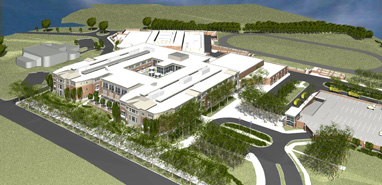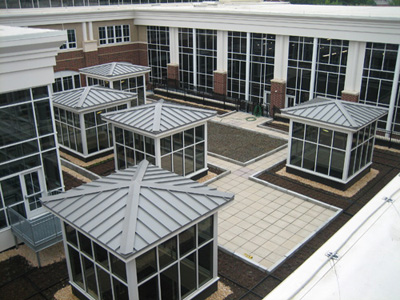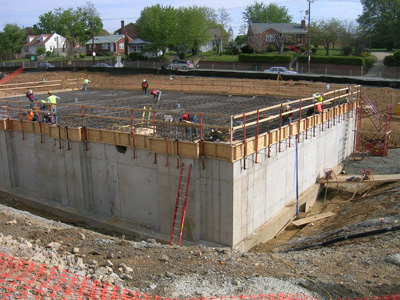
STRUCTURAL OPTION
TC WILLIAMS HIGH SCHOOL
ALEXANDIRA, VA
| |
| Home |
| Student Bio |
| Building Statistics |
| Thesis Abstract |
| Technical Assignments |
| Thesis Research |
| Thesis Proposal |
| Presentation |
| Final Report |
| Reflection |
| Senior Thesis e-Studio |
![]()
- Building name: TC Williams High School
- Location and site: 3330 King St Alexandria, Virginia 22302 (map)
- Building Occupant Name: TC Williams High School
- Occupancy or function types: High School ~ 2,500 Students
- Size: 461,000 SF
- Number of stories: 3
- Primary project team
- Owner: City of Alexandria, VA
- General Contractor and CM: Hensel Phelps
- Architects: Moseley Architects
- Engineers: Moseley Architects
- Dates of construction: July 02 2004 – June 21 2007
- Overall Project Cost: $87,000,000
- Project delivery method: Design Build - GMP
- Architecture Concepts:
- TC Williams High School was originally designed with a very modern feel, but the owner decided a more traditional look was desired. The TC Williams High school was then redesigned with a traditional look that took various designs from other buildings in the general area. Natural light was also a major factor in the design, and 70% of the rooms have an outside view.
- The other architecture concept the building was designed around was a Green Design. The building achieved a LEED rating of silver. Some of the main LEED designs included a 450,000 gallon Cistern, and a small green roof. The cistern will be used to provide water for the chillers, air conditioning, and toilets. The Green Roof will be used as a learning tool, as well as to collect additional rain water for the cistern.
- Major national model codes:
- Virginia State Building Code
- IBC 2000
- ASCE 7 – ‘99
- Zoning : Residential
- Building envelope:
- Roofing System:
- Typically 3” Roof Deck supporting 6” Rigid insulation, supported by Steel Joists.
- The Green Roof is designed with 9” Roof Deck with 6” Rigid insulation, supported by Steel Trusses.
- Exterior Wall Systems :
- Typically Non Load Bearing 12” CMU with 4” Face Brick
- Alternating with interior 12” CMU with 14” CMU covered by 4” Face Brick.
- Typically all Exterior Walls are Non Load Bearing. The exterior support is Steel Braced Frame Construction
Building Statistics Part I | (PDF) General Building Data Architecture Building Statistics Part II | (PDF) Structural The foundation of the building consists of both strip and spread NWC (145 pcf) footings with a compressive strength f’c = 3,000 psi. The foundations are constructed on sub grade soils improved by the installation of a ‘Geopier Rammed Aggregate Pier Soil Reinforcement’ system and are designed to bear on strata capable of sustaining a minimum bearing pressure of 6,000 PSF. Lighting / Electrical The classrooms are lit with 54W T5 HO 277V Pendant fixtures, while the corridors are lit with 32W T8 277V Recessed fixtures. Mechanical There are a total of 17 roof top air handling units with a combined capacity of 229,100 CFM suply conditioned air to the majority of spaces. An additional 4 indoor air handling units combine for 40,355 CFM suply air to the auxiliary gymnasium, east and west commons areas and the remaining spaces in the Eastern Classroom wing. These units employ the use of enthalpy wheels to recover total energy. Four natural gas-fired condensing boilers, with capacities of 1.68 million BTUH, heat water from 120˚F to 160˚F. Water is cooled to 38˚F by two, 600 ton water cooled, electrical chillers. Two 750 ton cooling towers condense the R-123 refrigerant so that it can be re-circulated through the chillers which will accept the heat from the systems chilled water lines. An additional water unit heater and an electric heater service the mechanical and equipment rooms respectively. A five zone, wet pipe sprinkler system services T.C. Williams High School. Each zone covers approximatly 50,000 sq. ft. A 100 hp vertical in-line fire pump produces a flow rate of 1,000 GPM with a total head pressure of 120 psi. A mixture of sidewall and pendant sprinkler heads will service the spaces while concealed heads are required in all the stairwells. Construction Hensel Phelps is the CM on the job, and had working under a design build guaranteed maximum price contract. Construction started in July of 2004, and construction was completed in June of 2007. The old school which currently resides next to the new school is still currently under deconstruction. Fire Protection The steel in the building is protected with spray on fireproofing rated for 2 hours for floor, and column members, and 1 hour for roof members. The floor slab has a required 2 hour minimum fire rating. A fire alarm system with automatic sprinklers is in place throughout the school. Transportation There are three main elevators located in the 3 story classroom sections. They are all for public use. |
---Green Roof--- ---450,000 Galon Cistern--- |


